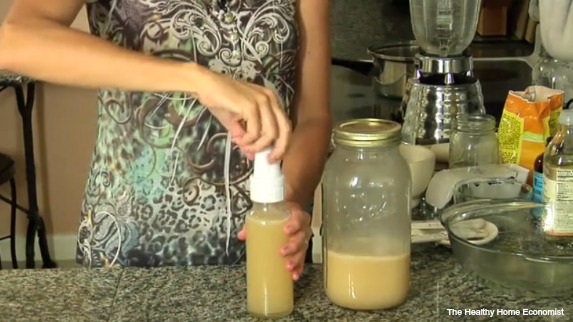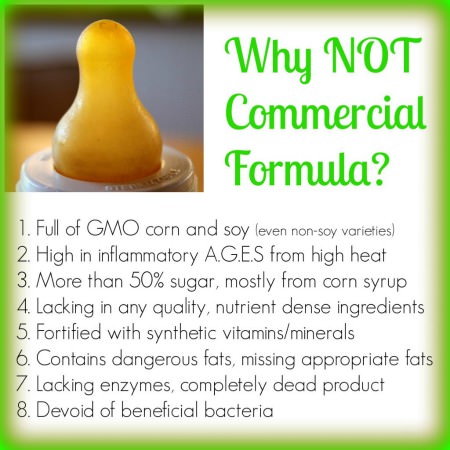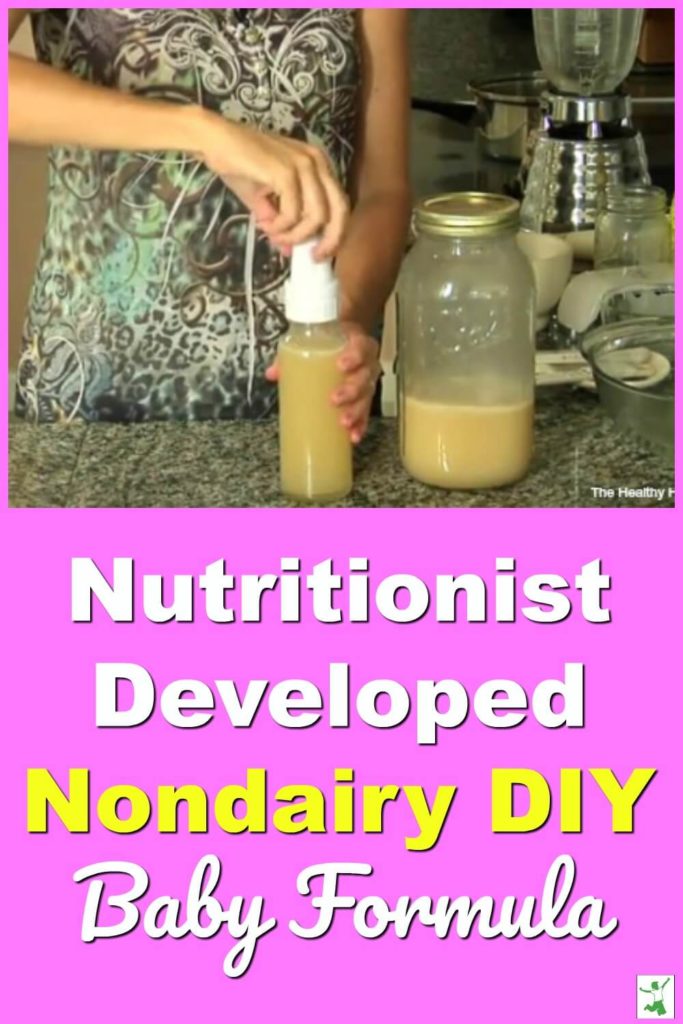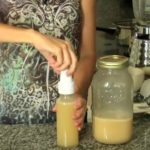Table of Contents[Hide][Show]
A nourishing, hypoallergenic homemade baby formula using safe, whole ingredients. This recipe was developed and tested by Dr. Mary Enig, a PhD Nutritionist and originally published in Nourishing Traditions cookbook in 1996. Source: Weston A. Price Foundation

Many health-conscious parents first try a homemade milk-based baby formula when it becomes apparent that breastfeeding is not an option. If baby demonstrates an intolerance even when using fresh, grass-fed whole milk or yogurt, the non-dairy homemade formula recipe is an excellent alternative to use instead. A detailed how-to video tutorial is also provided.
This dairy-free DIY formula is based on homemade broth and a small amount of cooked, organic grass-fed liver instead of milk as the source of protein.
The recipe was originally published in the cookbook Nourishing Traditions in 1996 and developed by Dr. Mary Enig.
Traditional cultures sometimes used liver pre-chewed by the Mother as a baby first food. Liver is very easily digested and full of nutrition and cholesterol for the baby’s rapidly developing brain.
Commercial nondairy formulas rely on soy as the protein source. Soy formula is a devastating food for babies as it is loaded with plant estrogens which wreak havoc with the baby’s developing hormonal system. In addition, soy contains some of the highest levels of phytic acid found in any food. Phytic acid contributes to poorly developed, cavity-prone baby teeth and poor bone structure (i.e., turned-in feet, flat feet, crowded teeth, sunken chest, etc) as it blocks mineral absorption.

Whatever you do, if your child cannot drink a milk-based formula, DO NOT use soy! Other types of plant-based DIY baby formula can cause growth problems as well.
What a relief for a concerned parent that a safe, healthy, non-dairy homemade formula can be made at home with nutrient-dense, whole-food ingredients.
Most babies who cannot drink the homemade milk-based formula THRIVE on this hypoallergenic homemade formula.
You will immediately notice that whey and lactose are used in this hypoallergenic recipe. The vast majority of babies will do fine with these milk-derived ingredients as it is the milk protein (casein), not the lactose or whey that was causing the problems with the milk-based formula. In the rare case that the infant is not thriving on this homemade dairy-free formula, remove the whey and substitute GMO-free dextrose or sucrose for the lactose.
Nondairy Homemade Formula
Click here for where to source all the ingredients for the dairy-free homemade formula such as gelatin, lactose, and acerola powder, etc. See the dairy-free baby formula video below for visual details.
One batch of 36 ounces takes about 10 minutes to make.
Be sure to use bottle nipples designed for thicker flowing liquids when feeding this formula to your baby. Get them here.
If your baby is only allergic to cow milk, but not other types of dairy, this article provides a how-to for making homemade goats milk formula if you would like to try that first. A sheep milk formula is an option too. Or, if you cannot get goat milk in your area, you can make homemade formula with camel milk.


Dairy-Free Homemade Formula Recipe
A nourishing, dairy-free homemade baby formula that uses bone broth as the base instead of raw milk that was developed and tested by Dr. Mary Enig to match breastmilk as closely as possible.
Ingredients
- 3 3/4 cups bone broth
- 2 oz grassfed liver beef, bison, or lamb
- 1/4 cup liquid whey leave out if baby cannot tolerate
- 5 Tbl goat lactose OR nonGMO dextrose if baby cannot tolerate
- 1/4 tsp bifidobacterium infantis powder
- 1/2 tsp cod liver oil unflavored
- 1 tsp sunflower oil preferably organic
- 2 tsp extra virgin olive oil preferably organic
- 1 Tbl virgin coconut oil preferably organic
- 1/4 tsp acerola powder
Instructions
-
Simmer liver cut up into small pieces gently in the homemade broth until just cooked through.
-
Liquefy the liver in the broth using a handheld blender or a food processor.
-
Let the broth cool to room temperature, then stir in the remaining ingredients or blend for a few seconds in a blender.
-
Store formula in glass jars in the refrigerator.
-
To serve the homemade formula, pour into glass baby bottles and warm in a baby bottle warmer or in a pan of hot water. Never microwave baby bottles!
Recipe Video
Recipe Notes
You may make bone broth yourself (most budget-friendly) or buy it. Be aware that almost all bone broth on the market is not good quality. Even if it is quality bone broth, it comes in toxic packaging. Watch out! The only brand I have found as of this writing that is worth purchasing is bone broth packaged in shelf stable glass jars.
Most babies allergic to milk formula are allergic to the milk proteins, so liquid whey is tolerated well. If baby shows signs of intolerance try using goat whey (strained from goat yogurt or goat kefir). Leave out only as a last resort. DO NOT use powdered whey from the store or whey from making cheese.
Substitute nonGMO dextrose or sucrose if the baby cannot tolerate lactose.
If your baby has a true dairy allergy and is not just dairy sensitive, this infant probiotic is dairy free to use as a substitute.
**Do not use krill oil as a substitute for the cod liver oil. It contains no Vitamin D and very little Vitamin A.








Hi Sarah,
I put my 10 month old baby on Sally Fallon’s raw milk formula two weeks ago. Since then he has been having at least 4 very watery stools a day. He also has eczema on his face that I was hoping to clear up with this formula. The eczema is still flaring. Should I keep giving him the milk? Do you suggest removing any of the items to help stop the loose stools and to help heal the eczema? I am a first time mom and would love any guidance from you!
Thanks!
Lisa
Sarah,
I apologize for my last post I was frantically trying to figure this all out as my daughter is 7 1/2 months old now and still cannot sleep day or night due to tummy troubles. I have located all ingreds and made my first batch today minus the whey as my milk was not spoiled and is taking a long time to seperate, but I have some questions for you.
1. My stock is no where near as clear and dark as yours in the video I used all organic grass fed bones and liver, and skimmed the fat. Is it ok to figure this will be different every batch?
2. How long is it safe to let your why and kurds seperate? Mine has been out for over 48 hrs, I tried to seperate thru a cloth this am and the “Kurd” part is quite solid but very little of it, and the whey portion is very yellowish in color not near as clear as yours so I put it all back in the container to try to seperate further. My concern is to not get any protien in the whey as she is definatly protien sensative.
3. what are we lacking leaving out the whey and should I put something in its place?
This first batch she will not get much of any way but I am hoping to know these answers for the 2nd or 3rd go round as I am hoping after letting her acclimate to it we will be able to go on full formula as I really need to treat my medical conditions that are untreatable safely while nursing:) Thank you so much for all your videos they have made this process a breeze!
Sarah,
I really need your help, I have my second malabsorber she is 6 1/2 months old and not doing well (better than brother as we have avoided all corn syrup sources) She cannot tolerate corn in the slightest, the only corn product (other than possible vitamin sources) in her formula is maltodextrin, and as a nursing mom I am giving her “empty” milk by cutting my diet down to white rice potatoes and meats, I cannot even take a vitamin supplement without her tummy aches. I am ordering the required supplies for the liver based and have found a different form of acreola powder without corn listed here, but I cannot find the nutrient info to see if its is the same as the concentrated now brand, heres the link http://www.mountainroseherbs.com/learn/acerola.php I cannot find pasture fed animals in my area as of yet (we live in corn country) until I find true pasture fed is it at least ok to use partally grain fed liver? have tons of other questions but cannot type as baby is upset as usual those will at least help me get started.
Sarah – thank you for your blog, I read it every day! I am making both the milk and liver formulas for my newborn as I am not yet producing enough milk and she needs to gain weight. On days when I just do the liver, she doesn’t seem to have gained as much weight on the following morning as on days when I give her the milk formula. Is there any harm in increasing the amount of oils a bit? Do you have any general guidance on that? Also, for the milk formula, you mention 2 or more T of cream. Is 4 T too many?
– Rebecca
Hi! My son was in the hospital and they took him off breast milk since they found he had allergies, they said he could go back on breast milk within a few weeks and by then I couldn’t keep it in. They put him on a formula because he has a soy and casein allergy. He is now 14 months old, refuses to eat any solids, and has high liver enzymes. Corn syrup goes through the liver (no one can figure out what he has and they just keep testing him) and I believe the formula is causing the issues. I have been trying almond milk a couple times a day and he seems to be feeling better. Since he has a casein allergy, the lactose should be fine, correct? Thank you!
Hi, is there a way to make the formula not so gritty? It instantly settles and clogs the nipple of the bottle. Not sure if I’m doing something wrong. I am using the new desiccated liver from Radiant Life.
Thanks if anyone can help!
Sarah F.
I strained it through cheese cloth and that worked perfectly.
p.s. My daughter also seems to get quite gassy on the liver based formula. What could be causing the gas?
Sarah, I see a light at the end of my tunnel. I wish I would have found this blog sooner. My daughter has had quite the time! I’ve discovered she can have nothing from the cow. She isn’t a huge fan of the broth, but I’ll keep trying it. Her stools are very loose though, and she seems to get gassy here and there. My questions:
1. Should I go to a dairy free probiotic?
2. I tried her on a lactose free formula, and she threw it up each time, so should I not consider lactose a problem?
3. She had very slow weight gain so far on this formula, I’m nervous to give her solids if her digestive tract is weak. Plus, the only solid she will eat is a dippy egg, minus the whites. I was told to include a raw egg in the formula, and a major butt rash happened.
Thank for your help in advance!
Hi Sarah, I’ve tried a number of different formula for my daughter after she had problems with breast milk. We’ve gone from an elemental formula to raw milk formula (constipated her) to raw milk formula with a kefir base (still constipated her) and now to liver formula which is causing eczema and loose/frequent stools. I am suspecting that I need to take out the whey and the lactose. Given the fact that she most likely has yeast overgrowth (we’re working on it!) I was wondering whether the dextrose or the sucrose would be the better option for her.
Thank you!